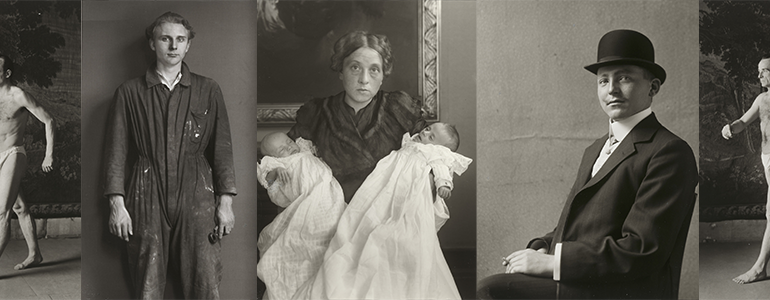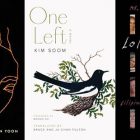Photography as Poetic Language in Emblems of a Passing World

There is something unpoetic about the photographs of August Sander. His life’s work, People of the Twentieth Century, was a project that searched for truth, order, and stability through portraiture. Sander aimed to study his German subjects with scientific clarity and organized them into a classificatory system, a kind of dictionary of social types. The project consists of over six hundred photographs organized into seven groups and forty-nine portfolios or subgroups. Sander’s taxonomy privileged the social and professional roles of each sitter more than individual character. Rather than identifying his sitters by name, each represented a type or occupation meaningful to society—Office Worker, Tannery Owners, Young Farmers, Leaders of a Splinter Party. The titles alone communicate the rapid changes occurring in early twentieth-century Germany, as the nation rapidly transformed from an agrarian society into an industrial powerhouse at an unbearable pace. Such turmoil no doubt inspired Sander’s attempt to make sense of it all.
As Adam Kirsch’s collection of poems Emblems of the Passing World: Poems after Photographs by August Sander (2015) demonstrates, however, the faces in Sander’s photographs insist on meeting us as individuals who experienced their unassuming contributions to their world in unique ways. As much as Sander tried to fix his subjects in particular social, professional, or familial roles, “humans,” Kirsch retorts, “are never that static.”
In his introduction to Emblems of the Passing World, which amplifies the tension between the social and the individual through a remarkable cross-talk between photograph and poetic text, Kirsch explains that his poems emerged from a process of conjecture, a way of looking that stands in contrast to the rigid signs and structure of physiognomic looking. We can make a historically informed guess that the two young sons who posed for Sander in Widow with her Sons in 1921 joined the Hitler youth and perished in World War II. But the exact fate of each individual photographed remains unknown. Kirsch explains, “It is this blank that the imagination of the viewer is compelled to try to fill, with hypotheses or narratives—or, in this book, poems.” Kirsch’s approach aims to emancipate what is suppressed in Sander’s taxonomic approach. As his work makes clear, this is what makes Sander’s photographs so compelling—that despite the project’s efforts to fix each portrait in a kind of deindividualized order, the particular of each human presses through.
Sander’s photographic project was one of the most influential of the twentieth century. But perhaps less recognized is how it suggested a new interdependence of the roles of writer and photographer. In a 1931 radio address to his fellow Germans, August Sander declared his faith in photography’s unique capacity to transform the understanding of human nature into something like learning a foreign language—not easy, but certainly possible. “Today with photography we can communicate our thoughts, conceptions, and realities, to all the people on earth,” he claimed. “If we add the date of the year we have the power to fix the history of the world.” Sander was one of several photographers in early twentieth-century Germany who declared that photography would obviate written text. But despite Sander’s claims, a photograph almost always demands explanation and invites narrative imaginings in uncontrollable ways.
People of the Twentieth Century affirmed a cruelly modern narrative of social progress and decline that Kirsch poem’s consistently challenge. Sander’s basic groupings began with portraits of farmers, then moved to the working classes and skilled craftspeople. The project peaks with intellectuals, artists, and the urban classes. The last section, “The Last People,” collects social outcasts, the disabled and poor. Like Sander, Kirsch takes special care in the organization and sequencing of the photographs—their arrangement and selection are as crucial to Kirsch’s project as his poetic words. Kirsch creates a less rigid structure, and he groups his selection of 46 of Sander’s photographs into four groups: farmers occupy the first group, middle-class and modern professionals are featured in the second, the family in the third. The fourth group seems to be a collection of political radicals and social outcasts. But these groups also contain many exceptions, and his poems draw attention to how Sander’s tidy social structure is a fiction. The poems teach us an alternative way of looking at these faces that makes room for the idiosyncratic details that defy rigid categorization. “Nature plays havoc with the stratified / Society we struggle to impose,” Kirsch begins his poem that accompanies Sander’s Fitter (1929) in section one, a portrait of a strapping man whose natural good looks clash with his dirty coveralls. Kirsch repeatedly challenges how Sander meant for us to look at his portraits, pointing to what defies their categorization rather than reenforcing it.
Modernity is filled with moments in which individuals mask their social status. In Sander’s The Butcher’s Apprentice (1911-14), a young man sits in a simple black chair. A cigarette rests in his left hand as his proud gaze meets the camera. He is dressed in a crisp suit and bowler hat. The only detail of the photograph that betrays his working-class occupation is the concrete wall behind him, which seems too industrial to host someone in such a pristine suit. (Sander often photographed his subjects in their professional or domestic surroundings, rather than a studio, to enhance their social identity.) It is painted white but seams and cracks peek through. Kirsch speculates that “in the closet hangs an apron flecked / With bits of brain beside the rubber boots / Stained bloody brown from wading through the slick.” These gruesome details soil the pristine scene of Sander’s photograph, suggesting that the complexities of social ambition and individual identity can never be captured in a single photograph.
Kirsch’s selection of Sander’s photographs also emphasizes the instances of personal poignancy that rupture his otherwise detached taxonomy. In My Wife in Joy and Sorrow (1922), Sander photographs his newborn sons in their mother’s arms. One son is alive and one is dead; both are dressed in long, white ceremonial gowns. Pulled from her unimaginable grief by her husband’s camera, the young mother looks stunned. Her shoulders are stiffly raised underneath her black dress to support the weight of her two babies. Kirsch writes, “What kind of father asks his wife to hold / Her dead child and her live one in her arms, / Then poses her and fiddles with the lights until the shot is perfectly composed?” Kirsch gives words to the suppressed cruelty of Sander’s approach to photography and highlights the tension—in the overall project, but in this image especially—between the detached objectivity of photography and its deeply human subject.
My Wife in Joy and Sorrow follows Mother and Child (1926), in which a working-class mother in a striped dress lifts the child in her lap to face the camera. This is a much more traditional portrait than the one on the proceeding page, but Kirsch doesn’t let it rest in the realm of the saccharine. His words draw attention to its stiff inauthenticity. “Newly introduced, they try / To feign familiarity,” the poem beings. Kirsch portends that the son will grow up to reject his mother, until “his torn body can’t refuse / The tenderness she lavishes.” One of the deepest pleasures of Kirsch’s words is their revelation of the unplanned details that never seem legitimately part of Sander’s compositions but are there, nonetheless. Caught in a momentary glance by Sander’s camera, the child appears to look at his mother with some trepidation. “The pose is right; but no one told / The newborn he’s supposed to hold / His mother’s gaze contentedly.” It is as if Kirsch points to Sander’s inability to control every detail of his photographs. This approach isn’t taken on by Kirsch as a critique of Sander. Rather, Kirsch points to a more complex tension in Sander’s work between the individual and its social roles.
Because they were taken during such an ominous historical moment, it is impossible to look at Sander’s photographs and not think about history. Kirsch’s poems amplify a latent tension between the historical and the individual, making room for each individual person and the conditions that existed outside of Sander’s frame. In this way, his poems pose questions about the relationship between historical forces and its individual actors, how one imposes its will on the other and whether they can be separated at all. In Kinetics Researcher from Vienna (1930), Sander shows a scientist in a full-length portrait, stripped to his underwear in a striding pose and in front of a large painted landscape. “Nakedness ought to be undatable,” Kirsch begins. But of course, it is datable, especially in Sander’s photograph, in which the striding scientists demonstrates “unembarrassed objectivity” as an emblem of the era. Kirsch’s poem makes clear that such ambitions of objectivity are one of the most emblematic efforts of the modern age.
Sander did not stand apart from the society and human experiences he intended to capture, and Kirsch ends Emblems of the Passing World with The Photographer, Sander’s self-portrait from 1925. This last image might be the starkest portrait in the book. Sander’s shoulders and head fill the frame and the photographer looks out at the camera with an intense and scrutinizing stare. “What you appear to be is what you are,” Kirsch writes, “Despite the pleas of subjectivity / Whispering there is more to you by far / Than the mere object you’re compelled to be / As soon as his remorseless shutter clicks.” The last poem balances the poles of Sander’s project—the personal idiosyncrasies and unclassifiable complexity of the individual against the stereotypes and quantitative understanding of human experience in modernity—and turns it all back on the photographer himself. Kirsch shows us that Sander’s project needs a textual guide. The poet, constantly complicating and undermining confidence in photography as a universal language, might be best suited to the task.



